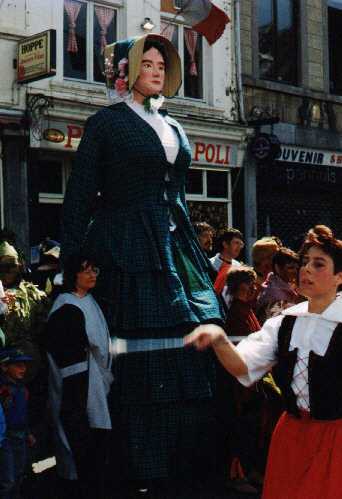
All sorts of giants
'Carried Dancing or Pageant Giants' is an exact description. The principle interest of the guild is in carried giants. There are giants made to run on wheels. Whilst wheeled giants have many merits and are a worthy subject for study in their own right, they don't don't move well, they can't dance and generally they're not in the same class. So there!
 Giants come in many forms. Some are made from scraps and bamboo and may be used by a family or a school. Some are made of advanced engineering materials and are operated by specialists. There is a whole class of giant figures, they might better be described as puppets, that are made for theatres. The rule that BIGG uses to decide which giants to include on our lists is permanence. If a giant is made to last, and if it seems likely to last and be used for at least a couple of years, then we're interested
Giants come in many forms. Some are made from scraps and bamboo and may be used by a family or a school. Some are made of advanced engineering materials and are operated by specialists. There is a whole class of giant figures, they might better be described as puppets, that are made for theatres. The rule that BIGG uses to decide which giants to include on our lists is permanence. If a giant is made to last, and if it seems likely to last and be used for at least a couple of years, then we're interested
On the left is Christopher III. His worthy predecessor, the first Christopher still stands in the Salisbury and South Wiltshire Museum, he's at least 420 years old. Christopher III was built by Jeremy Turtle ( in the picture too ) and friends. The new giant is to be seen every St. George's day at the 'Riding the George' pageant in Salisbury.
 This is Bertilac du Haut Désert, the green giant from the Gawain story. He's not a BIGG member. He is operated by the Graund Order of Guisers from London.
This is Bertilac du Haut Désert, the green giant from the Gawain story. He's not a BIGG member. He is operated by the Graund Order of Guisers from London.
G.O.G. were among the first groups to build modern British giants. their first giant 'Gogmagog' was for a time one of the biggest giants in Europe.
 This is Caroline Moore, one of the Dorchester Giants. Here she is seen watching a parade in Maastricht.
This is Caroline Moore, one of the Dorchester Giants. Here she is seen watching a parade in Maastricht.
Many European festivals are provided with giants as a matter of course. British giants are starting to appear at some of the bigger festivals.
The British Isles Giant Guild would like to make it easier for Giants from other parts of Europe to attend events in these Islands.
How giants are made.

BIGG Index
 Giants come in many forms. Some are made from scraps and bamboo and may be used by a family or a school. Some are made of advanced engineering materials and are operated by specialists. There is a whole class of giant figures, they might better be described as puppets, that are made for theatres. The rule that BIGG uses to decide which giants to include on our lists is permanence. If a giant is made to last, and if it seems likely to last and be used for at least a couple of years, then we're interested
Giants come in many forms. Some are made from scraps and bamboo and may be used by a family or a school. Some are made of advanced engineering materials and are operated by specialists. There is a whole class of giant figures, they might better be described as puppets, that are made for theatres. The rule that BIGG uses to decide which giants to include on our lists is permanence. If a giant is made to last, and if it seems likely to last and be used for at least a couple of years, then we're interested

 This is Bertilac du Haut Désert, the green giant from the Gawain story. He's not a BIGG member. He is operated by the Graund Order of Guisers from London.
This is Bertilac du Haut Désert, the green giant from the Gawain story. He's not a BIGG member. He is operated by the Graund Order of Guisers from London.
 This is Caroline Moore, one of the Dorchester Giants. Here she is seen watching a parade in Maastricht.
This is Caroline Moore, one of the Dorchester Giants. Here she is seen watching a parade in Maastricht.
